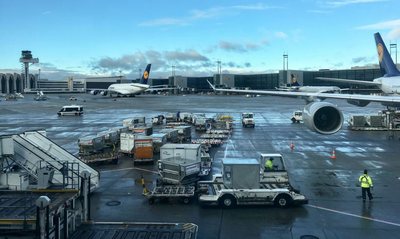Saving Money Implementing Aviation SMS

Not all aviation service providers are created equal.
- Charter operators;
- Airlines and airports;
- Aviation maintenance organizations (AMO);
- Flight schools; or
- FBOs.
Other larger operators may be more complex, having parent companies with a combination of different types of companies, including:
- Airlines;
- Helicopter operations; and
- AMOs.
Likewise, there are many aviation service providers operating simultaneously in multiple theaters, such as:
- North America;
- South America;
- Middle East; or
- Asia.
Related Aviation SMS Database Articles
- 3 Benefits of Aviation Safety Management System (SMS) Databases
- 7 Signs You Need an Aviation Safety Management (SMS) Database
- How to Choose the Best Aviation Safety Database Software
In this article, we'll discuss some common-sense database configurations for aviation safety management systems (SMS). This article is not intended for a beginner or for a simple operator.
Some complex operators have a desire to save money by having one database for the entire parent company. There are times when this could work, and other times when it will come back and bite you in the tender regions.
What Is an Aviation Safety Database Portal?
Before we start discussing aviation SMS database configurations for complex service providers, we should first define what is an aviation SMS database portal.
A Web-based SMS database portal is an organization's secure access via the Web to SMS data and documents commonly belonging to a single company. SMS data is logically segregated to ensure other companies do not see safety data from other companies.
Safety data may include:
- Safety policies and procedures;
- Hazard identification processes;
- Trending charts;
- Audits and checklists;
- Corrective action preventive action tracking data;
- Pictures or images of safety reports;
- Operational documentation;
- Safety surveys; and
- Meeting minutes.
This list is not all-inclusive. However, you should know that users' access to this database of information is based on permissions granted to each user by an administrator. For example, all users with the Department Head role can access all SMS data that is designed to be accessed by department heads. Likewise, all safety managers with access to a portal can see the same data. There may be some granular settings to further isolate access, but logic based on permissions is commonplace among SMS database configurations.
Trying to Save a Dollar for Required Safety Databases
The majority of aviation service providers are required to have an aviation safety database to store hazard reports. This includes most operators in Europe, as this became a law in November 2015. An Excel spreadsheet is not a database; therefore, operators storing reported safety issues solely in a spreadsheet are not compliant.
Most aviation service providers are profit-driven. Therefore, they want to do as much as possible by expending the least amount of resources. It is natural for complex operators to want to use a single database for all their SMS database needs. Let's look to see if you need more than one safety database.
Related Articles on Using Spreadsheets in Aviation SMS
- 5 Things Spreadsheets Can't Do for Your Aviation SMS
- Spreadsheets vs Software for Aviation Safety Management
- Why EASA Aviation Service Providers Require Safety Reporting Database
Common Scenarios for Aviation SMS Database Configurations

A homogeneous company with fewer than 100 employees operating at a single location will commonly have:
- One safety portal with one division.
By homogeneous, I'm referring to a single type of operation, such as an:
- Airline;
- Helicopter operator;
- AMO;
- FBO;
- Charter operator; or
- Flight school.
To understand the concept of aviation safety divisions within SMS Pro, please refer to these two articles:
- What Are Divisions in My Safety Management System
- How to Use Divisions in SMS-Pro's Aviation Safety Database Program
Larger Aviation Operations
Airlines with more than 100 employees commonly have multiple divisions (or you may call them departments), such as:
- Flight ops;
- Air-side;
- Ground-side;
- Ground ops;
- Engineering;
- Administration; and
- Safety & Quality.
These operators will have one portal storing all SMS data within one database but separated logically by division. This allows an operator to generate meaningful reports that can focus on a specific division or aggregate data across the entire company.
There are many aviation service providers with mixed types of operations, such as
- Fixed wing;
- Rotor wing.
They may not have a certificated AMO. Smaller mixed operators may consider a single safety portal with multiple divisions, with each division focusing on a different type of operation. However, if these two types of operations exist under separate certificates, or are at different locations, it is best to have a separate safety portal for each type of operation.
Related Aviation SMS Database Articles
- What Is an Aviation Safety Database
- 5 Most Important Things to Know Before Buying Aviation SMS Database
- Tips Writing SMS Manuals With Aviation Safety Database Solutions
Why Does It Matter How Safety Data Are Stored?
In most cases, management requires reports for each type of operation. When all data are bunched together, it becomes increasingly difficult to identify risk management strategies for a particular type of operation based on data thrown into a single bucket.
Furthermore, management may want to isolate data from employees belonging to other operating segment types. For example, management may find it overwhelming or irrelevant for employees in the rotor-wing operation to see data belonging to the fixed-wing division, and vice-versa.
When a complex operator has separate companies operating in different countries, such as Canada and Chile, then this operator is recommended to have two separate portals that can be answerable to respective regulatory authorities.
Important Note: Each company segment with separate portals can store data in the same aviation safety database. Data is logically separated but shares the same data structure.
Because safety portals commonly use the same database, safety reports and key performance indicator (KPI) data can be aggregated simply in real-time, providing a user possesses the proper permissions. These reports are often aggregated in a "management portal."
This is an important concept to understand: although data is logically separated from employees in separate portals, a management portal possesses the ability to aggregate reports of all configured child (or associated) portals.
Large Groups of Simple Operations – Keep It Simple

You may have a company with:
- 20 FBOs; or
- 6 AMOs, 3 FBOs, and a charter operation.
In the first case of the 20 FBOs, you may want to group your FBOs by region and create a division for each region. You should still have only one portal for ease of management.
Larger companies with many FBOs may have a safety manager for each region that reports to the Director of Safety. In rare cases, I have seen companies with only one safety manager for the entire group. In any case, when a hazard is reported, the safety manager must know which Department Head to assign the issue to. If you are a safety manager in this scenario, and you don't know who should treat a reported issue for a specific FBO or AMO under your charge, you have three options:
- Get another safety manager for that group; or
- Learn more intimate organizational details about the organization's other holdings; or
- Do nothing and hope for the best.
In the second case above of the six AMOs, you may want a division for the FBOs, another division for the charter operator; and if possible, either put all the AMOs into a single division or break them out into geographic regions.
There are other companies with other simple group configurations, such as:
- A flight school;
- A couple FBOs; and
- A charter operation.
In cases like this, you are recommended to have one portal in the SMS database, with each business as a division.
Related Aviation SMS Database Articles
- When to Design Your Own Aviation SMS Database
- Pros and Cons of In-House SMS Database and Off-the-Shelf-Solutions (COTS)
- How to Manage Aviation SMS Without Complex Databases
How Will You Use Aviation Safety Data in the Long Term?
When making decisions as to how to structure your aviation safety database, you should be considering how your company will be using this data in the long run.
You may think you are saving a few dollars in the short term by putting all your data into the same basket. In the long run, you may be crippling your SMS trending report capabilities.
Conversely, we have seen operators who try to "over-architect" their aviation SMS database. There is a time to keep it simple. If in doubt, consult an SMS database professional.
We have worked with literally hundreds of aviation service providers around the world. And no, I have not yet seen it all. I am still learning new things about how aviation service providers structure their companies.
If you have questions about structuring your aviation safety database, feel free to contact us. No obligations. We will share our insights freely.
If you would like to see some short demo videos on what an aviation SMS database can offer you, please watch these short demo videos. SMS Pro has been working with operators since 2007 with their aviation SMS databases.
Live SMS Pro Demo
Have questions? Want to see SMS Pro live? Sign up for a live demo.
Last updated in January 2025.









